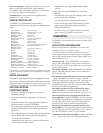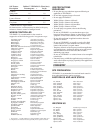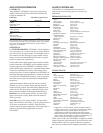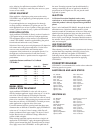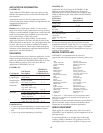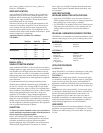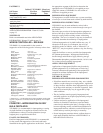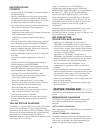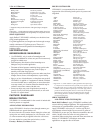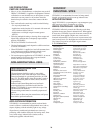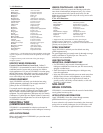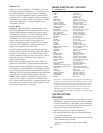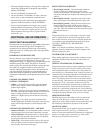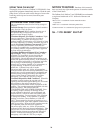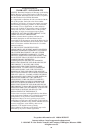
3 - 4 Gallons/Acre
* Suppression – a visible reduction in plant population and/or plant
vigor as compared to an untreated area and generally not accepted
as control.
** Suppression may result with some of the giant (larger)
smutgrass species.
SPECIFIC WEED PROBLEMS
Control of Canada Thistle in Crown Vetch - DuPont™
VELPAR® L is recommended for control of Canada thistle in
established stands of crown vetch on noncrop sites. Make a
single application of 3–5 pints of VELPAR® L from late spring
through mid-summer, when thistle is actively growing prior to
flowering. Do not use a surfactant. Some discoloration of the
crown vetch foliage may occur after application.
SPRAY EQUIPMENT
Apply VELPAR® L uniformly over the desired area using
ground equipment or helicopter. Do not apply more than 3
gallons per acre of VELPAR® L by air.
Use enough water for thorough coverage. For ground
a
pplica
tion this is usuall
y 25 gallons per acre. Higher volumes
may be needed to obtain uniform application with handgun
equipment. For aerial applications (helicopter only) this usually
a minimum of 5 gallons per acre. Higher volumes of water may
be needed when wa
ter temper
a
tures are cold or the higher rates
of VELPAR® L are used.
INDUSTRIAL TURF
(UNIMPROVED ONLY)
VELP
AR®
L is r
ecommended for selective weed control in
established stands of bermudagrass and/or bahiagrass in noncrop
areas.
APPLICATION TIMING
Make a single application of VELPAR® L per year when weeds
are actively growing.
WEEDS CONTROLLED - USE RATE
VELPAR® L effectively controls the following weeds at the
rates shown in industrial turf (unimproved only). Use a lower
r
ate on coarse-textured soils (sand to sandy loam). Use the
higher rate on fine-textured soils (clay loam to clay) and on soils
high in organic matter.
2 3/4 - 4 1/2 Pints/Acre
* Suppression may result with some of the giant (larger)
smutgrass species. Suppression – a visible reduction in plant
population and/or plant vigor as compared to an untreated area and
generally not accepted as control.
SPRAY EQUIPMENT
Apply VELPAR® L uniformly over the desired area using
ground equipment only.
For ground application, use enough water for thorough coverage
usually a minimum of 25 gallons per acre. The use of a
surfactant is not recommended.
USE PRECAUTIONS
INDUSTRIAL UNIMPROVED
TURF
• Use VELPAR® L only in stands of bermudagrass and
bahiagrass established for at least one year. Do not treat newly
sprigged or sodded areas.
• Some discoloration of the bermudagrass or bahiagrass may
occur after application.
• Injury may result when desirable grasses are under stress from
drought, insects, disease, cold temperature, or poor fertility.
• Severe turf injury may occur if applications are made on
gravelly or rocky soils, thinly covered subsoils, or soils with
less than 1% organic matter.
NON-CROP
BRUSH CONTROL
VELPAR®
L is recommended for the control of undesirable
woody plants in noncrop sites.
APPLICATION INFORMATION
A
ppl
y
VELPAR®
L from late winter through summer,
prebud break until new growth hardens off.
In areas w
her
e the soil r
emains fr
oz
en during the winter and
spring rains are usually inadequate for soil activation, a fall
or winter treatment may be applied before the soil freezes.
Barley, little Hordeum pusillum
Barnyardgrass Echinochloa crus-galli
Dogfennel Eupatorium capillifolium
Fescue Festuca spp
Lespedeza Lespedeza cuneata
Oxalis Oxalis spp
Passionflower, maypop Passiflora incarnate
Pepperweed, Virginia Lepidium virginicum
Pigweed Amaranthus spp
Smutgrass* Sporobolus indicus
A
ster, heath
A
ster ericoides
B
ahiagrass*
P
aspalum notatum
B
ermudagrass*
C
ynodon dactylon
B
lackberry
R
ubus spp
B
luegrass
P
oa spp
B
roomsedge
A
ndropogon virginicus
C
amphorweed
H
eterotheca subaxillaris
C
anada thistle*
C
irsium arvense
C
arrot, wild
D
aucus carota
C
hickweed
S
tellaria media
C
lovers
T
rifolium spp
D
ewberry
R
ubus trivialis
D
ogfennel
E
upatorium capillifolium
F
escue*
F
estuca spp
F
ingergrass
D
igitaria ciliaris
F
oxtail
S
etaria spp
G
uineagrass
P
anicum maximum
Honeysuckle Lonicera spp
Horseweed/marestail Conyza canadensis
Lantana Lantana camara
Lettuce, prickly Lactuca serriola
Natalgrass (red top) Rhynchelytrum repens
Plantain Plantago spp
Ragweed, common Ambrosia elatior
Smutgrass** Sporobolus indicus
Spanishneedles Bidens bipinnata
Vaseygrass Paspalum urvillei
21



